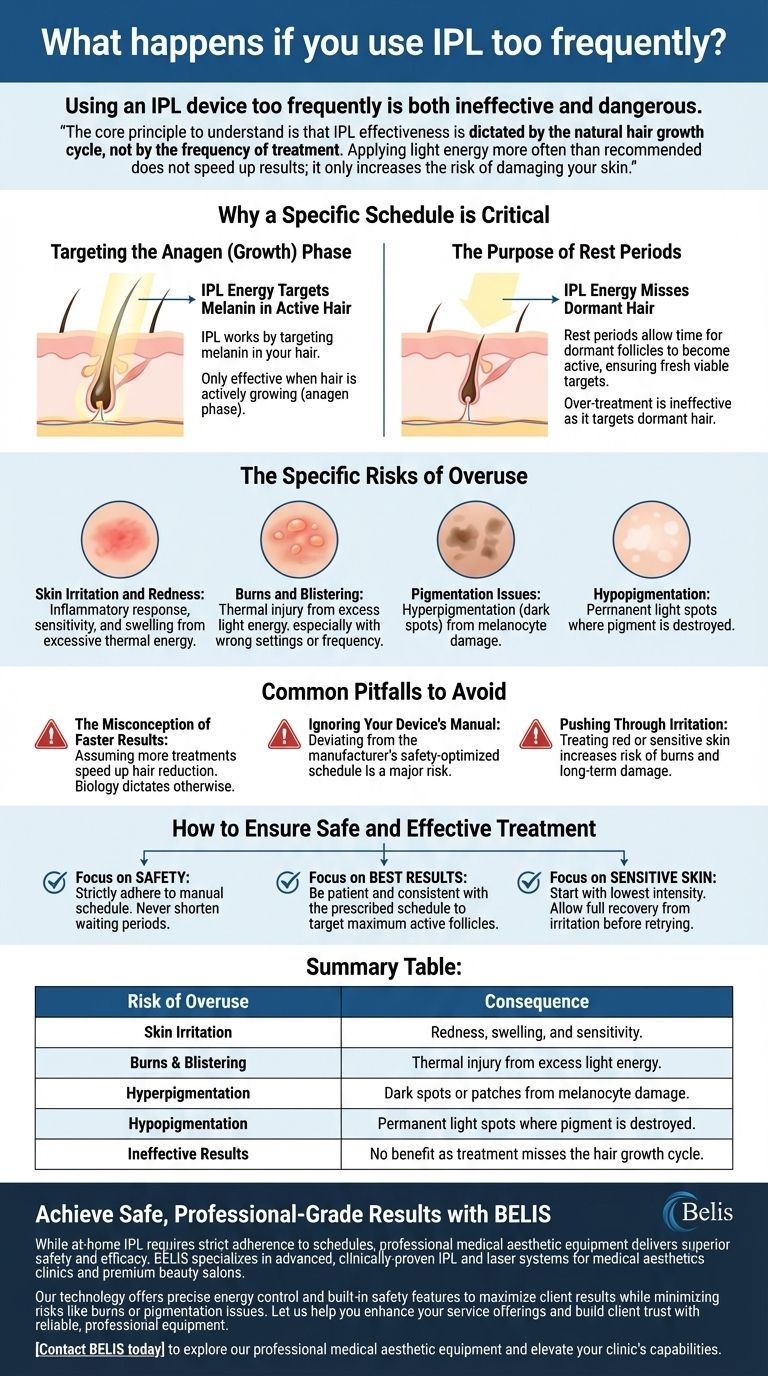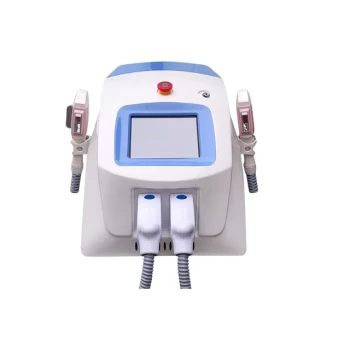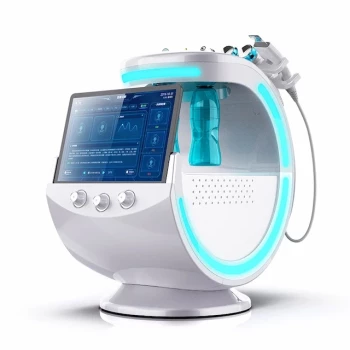Using an IPL device too frequently is both ineffective and dangerous. The instructions provided with your device are designed to maximize results while preventing skin damage. Overusing an IPL device can lead to adverse effects ranging from minor skin irritation to more severe issues like burns or lasting pigmentation changes.
The core principle to understand is that IPL effectiveness is dictated by the natural hair growth cycle, not by the frequency of treatment. Applying light energy more often than recommended does not speed up results; it only increases the risk of damaging your skin.

Why a Specific Schedule is Critical
The waiting period between IPL sessions is not arbitrary. It is based on the fundamental biology of how your hair grows and how Intense Pulsed Light interacts with it.
Targeting the Anagen (Growth) Phase
IPL works by targeting melanin—the pigment in your hair. The light energy travels down the hair shaft to the follicle, where it converts to heat and damages the follicle's ability to produce new hair.
This process is only effective when the hair is in its active growth phase, known as the anagen phase. During this time, the hair is physically connected to the follicle, providing a direct pathway for the light energy.
The Purpose of Rest Periods
At any given time, only a fraction of your body's hair is in the anagen phase. The rest is in transitional or resting phases, where IPL has no effect.
The recommended rest period (typically one to two weeks initially) allows time for other, dormant hair follicles to enter the active anagen phase. This ensures each treatment has a fresh set of viable targets.
The Ineffectiveness of Over-Treatment
Using your device daily or every few days on the same area is futile. You are repeatedly treating skin where the active follicles have already been zapped, and the dormant ones are not yet ready. You are simply exposing your skin to intense light without any therapeutic benefit.
The Specific Risks of Overuse
When you ignore the recommended schedule, the excess light energy that isn't being absorbed by hair follicles gets absorbed by your skin, leading to a range of problems.
Skin Irritation and Redness
The most common side effect is an inflammatory response. Your skin becomes red, sensitive, or swollen as it reacts to the excessive thermal energy.
Burns and Blistering
In more serious cases, the skin can absorb enough heat to cause a legitimate thermal burn. This happens when the device's intensity is too high for your skin tone or when the skin is treated too frequently without time to recover.
Pigmentation Issues
This is one of the most significant risks. Over-treatment can damage your skin's melanocytes—the cells that produce pigment.
This can result in hyperpigmentation (dark spots or patches) or, conversely, hypopigmentation (light spots) where pigment has been permanently destroyed.
Common Pitfalls to Avoid
Trusting the process is essential for achieving the results you want without compromising the health of your skin.
The Misconception of Faster Results
The most common mistake is assuming that more treatments will lead to faster hair reduction. The biology of the hair growth cycle makes this impossible. Patience and consistency with the correct schedule are the true keys to success.
Ignoring Your Device's Manual
Every at-home IPL device is different. The manufacturer has conducted clinical testing to determine the optimal balance of safety and efficacy for their specific technology. Deviating from their provided schedule is taking an uninformed risk.
Pushing Through Irritation
Never treat skin that is already red, sensitive, or irritated. This is a clear signal that your skin's barrier has been compromised and needs time to heal. Treating irritated skin dramatically increases the risk of burns and long-term damage.
How to Ensure Safe and Effective Treatment
Your approach should prioritize your skin's health first, which will naturally lead to the best possible results.
- If your primary focus is safety: Strictly adhere to the treatment schedule outlined in your device's manual. Never shorten the waiting period between sessions.
- If your primary focus is achieving the best results: Be patient and consistent with the prescribed treatment schedule. This ensures you target the maximum number of active follicles over time.
- If your primary focus is managing sensitive skin: Always start with the lowest intensity setting. If you experience any irritation, allow your skin to fully recover before trying again at an even lower setting or extending the time between sessions.
Ultimately, successful IPL treatment is achieved through precision and patience, not power or frequency.
Summary Table:
| Risk of Overuse | Consequence |
|---|---|
| Skin Irritation | Redness, swelling, and sensitivity. |
| Burns & Blistering | Thermal injury from excess light energy. |
| Hyperpigmentation | Dark spots or patches from melanocyte damage. |
| Hypopigmentation | Permanent light spots where pigment is destroyed. |
| Ineffective Results | No benefit as treatment misses the hair growth cycle. |
Achieve Safe, Professional-Grade Results with BELIS
While at-home IPL requires strict adherence to schedules, professional medical aesthetic equipment delivers superior safety and efficacy. BELIS specializes in advanced, clinically-proven IPL and laser systems for medical aesthetics clinics and premium beauty salons.
Our technology offers precise energy control and built-in safety features to maximize client results while minimizing risks like burns or pigmentation issues. Let us help you enhance your service offerings and build client trust with reliable, professional equipment.
Contact BELIS today to explore our professional medical aesthetic equipment and elevate your clinic's capabilities.
Visual Guide

Related Products
- IPL SHR Hair Removal Machine for Permanent Hair Removal
- Clinic Use IPL and SHR Hair Removal Machine with Nd Yag Laser Tattoo Removal
- Clinic Use IPL SHR ND YAG Laser Hair Removal RF Skin Tightening Machine
- IPL SHR+Radio frecuency machine
- Trilaser Diode Hair Removal Machine for Beauty Clinic Use
People Also Ask
- How quickly do you see IPL results? A Realistic Timeline for Clearer Skin
- Does IPL hair removal actually work? Achieve Long-Term Hair Reduction
- What should I look for in an IPL machine? Key Features for Effective Hair Removal
- Who should not use IPL? Key Contraindications for Safe Skin Treatment
- Does IPL work on all skin types? The critical role of the Fitzpatrick scale in safety and results



















